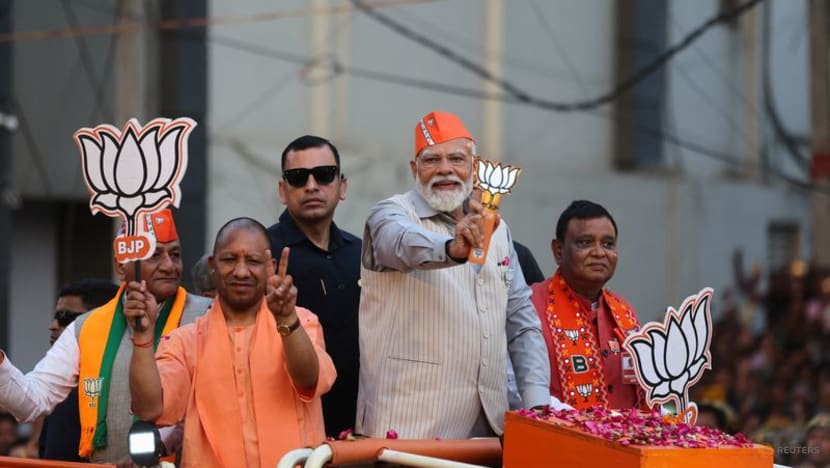Mixed views on Indian Prime Minister Narendra Modi’s decade of leadership ahead of general elections
In the world's biggest democratic vote, 968 million people will be eligible to cast their ballots in the upcoming elections.

Chief Minister of Uttar Pradesh Yogi Adityanath (left) stands next to India's Prime Minister Narendra Modi (right) who is holding election material during his roadshow, ahead of the general elections, in Ghaziabad, India on Apr 6, 2024. (File photo: Reuters/Anushree Fadnavis)

This audio is generated by an AI tool.
GUJARAT: As India prepares to kick off its six-week general elections on Friday (Apr 19), the country’s Prime Minister Narendra Modi is widely seen as being in pole position to win a rare third term in power.
Despite Mr Modi’s party's confidence in another victory, there are mixed views on what the leader has achieved during his decade of running the country.
“At the end of 10 years, he remains popular, and there has hardly been any prime minister of India who's remained as popular as he was at the beginning of his term,” said political commentator Neerja Chowdhury.
Mr Modi came to power in a landslide victory in 2014, speaking during his election campaign of his rise from selling tea as a boy to climbing the ranks of national politics to reach its pinnacle.
In the world's biggest democratic vote, 968 million people will be eligible to cast their ballots in the upcoming elections.
WHY MR MODI REMAINS POPULAR
The introduction of several generous welfare schemes has helped sustain his popularity, said Ms Chowdhury, author of How Prime Ministers Decide, a book which chronicles the pivotal decisions taken by six of the country’s leaders.
These include free grain for 800 million Indians, gas subsidies, and cash handouts for women from low-income families. Mr Modi has also taken credit for his government lifting 250 million Indians out of poverty according to him.
His supporters also often point to how well Asia’s third-largest economy has performed while he has been in power.
India is the world's fastest-growing major economy, with official data showing that its gross domestic product (GDP) expanded by 8.4 per cent in the October to December quarter last year, higher than the 7.6 per cent recorded in the previous three months.
Some Indians have taken pride in the development.
“There has been a lot of development all over India. Many states are there like Gujarat state, UP (Uttar Pradesh) state. In all of these states, Modi has done very beautiful work, like infrastructure and development,” one citizen said.
However, not all Indians feel they have enjoyed the returns from this growth, pointing to unemployment which remains an issue in the country.
The International Labour Organization estimated that 29 per cent of the country's young university graduates were unemployed in 2022.
GRIPES AGAINST MR MODI’S GOVERNMENT
“The cost of living is increasing, prices are going up. These people have just one agenda, Hindu-Muslim, and they don't focus on the real issues,” said another citizen. He was referring to criticism that Mr Modi and his party are fueling religious disputes, a charge that they deny.
While average incomes have risen, International Monetary Fund data showed that inflation has hovered around 5 per cent during the 10 years Mr Modi has been in office, dipping below the 4 per cent level only twice.
As the leader of the nationalist Bharatiya Janata Party (BJP) in a country where Hindus form the majority of the population, Mr Modi has also pushed hard on the party's religious agenda.
“He is what is called the king of Hindu hearts. So somewhere, that has had an appeal, and it's polarised society along Hindu-Muslim lines, majority-minority lines. The BJP has played on all the fault lines,” said Ms Chowdhury, who is also a veteran journalist.
In 2019, the Modi government also passed a citizenship law which excludes Muslim migrants. The United Nations Human Rights Office called the move "fundamentally discriminatory", which the government rejects.
However, polarisation is an ongoing theme for Mr Modi, going back to when he was chief minister of Gujarat state in the 2000s, where his home town is.
Many credited him with transforming the economy there. But he has also been a controversial figure, accused by some of turning a blind eye to deadly inter-communal riots in 2002 that claimed hundreds of lives. Mr Modi was effectively banned from the United States because of questions over his role in the riots.
PRIDE AT HOME
However, over the past decade, Mr Modi has travelled extensively to build relations with the world's most powerful leaders and has been warmly welcomed at the White House.
Apart from boosting India's image internationally, Mr Modi has focused on improving India's infrastructure, expanding the manufacturing sector, and growing the country's digital economy.
While there is no reliable evidence to support Mr Modi’s narrative that he used to help his father sell tea in the village of Vadnagar in Gujarat, there is a model of him as a tea street vendor at the local museum. His primary school has been redeveloped as a centre for students to be inspired.
Mr Shamaldas Modi, a relative of the prime minister who was brought up in the same household, told CNA: “If he has a job to do in mind, he does it. He won’t listen to others.
“No one can stop him. His mind is very sharp.”















